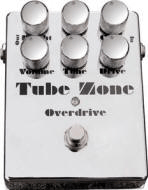 |
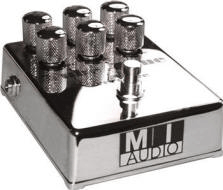 |
|
fig. 1 front |
fig. 2 back |
Last modification: 01/19/08 19:26
(click pics to enlarge)
(Note: This review first appeared on Harmony Central, but has been updated and presented here in a nicer format. Some thoughts in regard to its circuit design follow.)
Product: MI Audio TubeZone Overdrive Pedal Mk. III
Price Paid: USD 189.99
Ease of Use : 9
Having six rotary knobs on a pedal may seem overwhelming at first - is this is an overdrive, or a tube preamp? But no, this is pretty familiar territory for guitarists. Of the six knobs, four (Volume, Drive, Mid, Bright) work just as you'd expect - but the last two (Tone and Character) need a bit of clarification.
Tone, on most overdrives, is usually just a simple treble-rolloff - but here, it's a powerful EQ seesaw balanced around the mids. Rolled counterclockwise, the lows boost while the highs decrease; roll clockwise and the opposite happens. "Flat" for this knob is about 2:30 on a clock face. In practice, this knob is very useful - once you've got everything setup, the Tone and the Drive knobs are often the only knobs you find yourself tweaking.
The "Character" knob has a rather lengthy explanation in the documentation that succeeds in being both technical and vague at the same time. I spent a lot of time playing with this on the test bench, so let me tell you what it almost certainly is: a highpass filter for the generated distortion components. At low levels of Drive, the Character knob doesn't do much at all (little distortion, after all) - but at higher levels of Drive, rolling this knob left results in a clear and tight low-end. Most people will leave this knob fully counterclockwise and forget about it - but if your aim is vintage fuzz, or are thinking about chaining more than one overdrive in series, rolling this knob right bypasses the filter leaving the distortion overtones au naturel.
Hidden inside the unit is a "Presence" trimpot which may very well just be an internal trim for the Tone control. Counter-clockwise acts like a mid-treble boost, clockwise cuts.
Access to the battery compartment requires a screwdriver, like an MXR pedal.
Sound Quality : 10
This pedal is flexible, in all the ways an overdrive pedal should be. First, let's get something out of the way first because a lot of people don't seem to fully grasp what an overdrive pedal is. They're signal-conditioners designed to make life better for the (preferably tube) preamp that follows. Typical roles for overdrive pedals include rolling off the lows, juicing the mids, possibly boosting the treble, adding a modest amount of 'touch sensitive' saturation and some signal boost - all things to help make the dirty channel of your amp shine. They are not meant to be distortion pedals, nor are they aimed to sound flattering when plugged directly into a mixer or sound card. Not everyone understands this, so what we're seeing is an industry trend to blur the line between overdrive and distortion pedals. An example of an "old school" overdrive would be the BOSS SD-1, one of the most gentle overdrives ever manufactured and favored by both Van Halen and Zakk Wylde. This is a popular pedal now, but back in the day it wasn't well received because it didn't sound tough enough (!) ...and completely misses the point.
The point of bringing this up is that the Tube Zone gets the overdrive purpose correct, yet - and this is almost gravy - it's also a bomb when cranked to extremes. If you're using it for its intended purpose as a tube-amp juicer, you will able to dial in The Exact Amount Of EQ And Drive to get the job done right. Ever wonder why there are so many mods for the Tube Screamer? Because one size does not fit all - the knobs you see on the Tube Zone are controls that should have been on boxes like this all along. That said, the Tube Zone has at least one additional clipping stage (the manual claims 4, but I'm dubious) and when you crank it up the tones are rich, thick and tight. You can absolutely use this pedal for "Stack In A Box"-type purposes, (see the YouTube vid) but this is a bonus that goes well above and beyond the call of overdrive duty.
The pedal is also True Bypass. I haven't fully verified this, but I have every reason to believe that if you turn the pedal off with guitar plugged in, the battery will not wear down.
Reliability : 10
Reliability looks good - the case and switches look like a cross between an MXR
Distortion II and Mesa-Boogie V-Twin. The all-metal case is chrome plated, inside and out - not
the cheap plastic stuff that often passes for chrome. The footswitch has a
seriously satisfying old-school snap, and the bright blue LED gets even brighter
when running the pedal at higher-than-9V levels using an external power supply (I'm
currently using a 15VDC/1000 mA RadioShack adapter, Cat. #273-1691 - The manual claims that you
can go as high as 25V for additional headroom.) There's
also a heavy-duty looking diode on the PC board near what looks like a
power supply resistor, which may be a sign that the device is protected from
reverse-voltages. If so, good - not all pedals bother to do this.
Biggest worries involve scratches and fingerprints, because it's just so gosh-durned
purty.
Customer Support : N/A
I've never had to talk to Michael Ibrahim or anyone else at MI Audio (as of this
writing - see below!), but the
pedal is warranteed for five years. However, this does mean shipping it off to
Australia...
Overall Rating : 9
I've completely happy with this pedal, which has done everything I've asked of
it. I've gone through several overdrives, none of which were flexible or sufficiently
good-sounding to meet my requirements, but I'm quite happy with this one and
would buy it again. It's a solid tonal foundation that you can adapt to your own
needs,
as opposed to grumbling because something "ain't quite right
about it."
 TubeZone Overdrive Demonstrations |
|
YouTube Video
#1 YouTube Video #2 |
| Full Mix (TubeZone -> AMT SS-20 tube pre -> direct) |
|
Ibanez TS-9 TubeScreamer |
MI Audio Tube Zone |
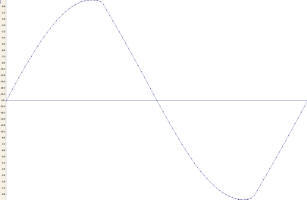 |
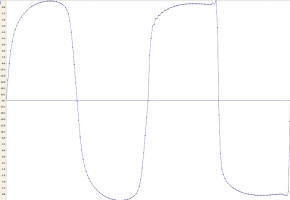 |
|
1KHz, Medium Drive, Normalized |
1KHz, Med (left) & Raging (right), Normalized |
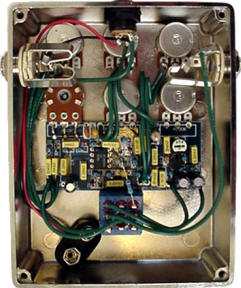
fig. 3 back cover removed
Note LM833 dual op amp (center left) and presence trimpot (center right)
Active part count: 1 IC, 2 transistors, 5 diodes and a bright blue LED
![]() Modding
The TubeZone
Modding
The TubeZone
A few weeks after using my Tube Zone heavily, I discovered how useful the internal "Presence" control (aka VR7, an internal 20K linear trimpot) was for general EQ'ing purposes. Unfortunately, it didn't take too many twists for this to get worn out, but heck - still under warranty, right? Considering the amount of effort involved in shipping the unit back to Australia for repair, Michael Ibrahim of MI Audio agreed with my suggestion that adding an external control might be a good idea. Hence, The Mod:
Round-trip from California to Australia for this bit of minor surgery took 9 weeks, but all it cost me was the shipping. Thanks, Mike!
Plusses:
Versatile in every way! Very attractive EQ and saturation, easy to tweak
Hand-built, tidy and simple layout - proven op-amp, used in better TS-9 mods
Third-generation design - Michael's been improving this one for some time.
Quiet, even at highest levels of gain
Minuses:
Pricey ($199 USD list) and rather hard to find. Online sources incl.
Bananas at Large,
Music123.com,
Guitar Pedal Store and
ProGuitarShop.com.
Repairs mean shipping back to Australia
Chrome plating, while gorgeous, is a fingerprint (and possibly scratch) magnet
Wish List:
Easier-to-replace battery compartment
Schematics! (Too much to ask, I know...)
Personal Observations:
"Neutral EQ and Unity Gain” on the Tube Zone, at least as far as pink noise is concerned, is approximately:
Bright, Mid, & Char: Full up (although Char doesn’t do much at low Drive
levels). Volume: 2 o’clock, Tone: 2:30, Drive: Min. Presence Trim: Centered.
Even so, you can only get so flat - there’s still a 3dB/octave rolloff beginning
around 3KHz (it's an overdrive, not a direct box!)
You can read the TubeZone documentation here. (PDF)
Contact:
www.miaudio.com (Australia)
MI Audio on Wikipedia